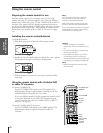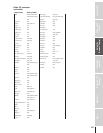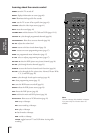
Introduction
Connecting
your TV
Using the
Remote Control
Setting up
your TV
Using the TV’s
Features
Appendix
Index
10
Connecting two VCRs
This connection allows you to record (dub/edit) from one VCR to
another VCR while watching a videotape. You can also record from
one TV channel while watching another TV channel.
You will need:
• one coaxial cable
• two pairs of audio cables (two single audio cables for mono
VCRs)
• two video cables (two S-video cables for S-VHS VCRs)
OUT
RL
VAR
AUDIO
OUT
VIDEO
L/
MONO
IN
L
R
P
B
P
R
Y
L/
MONO
AUDIO
S-VIDEO
VIDEO
R
VIDEO-1 VIDEO-2
COLOR
STREAM
AUDIO
AUDIO
ININ
L
R
R
AUDIO
COLOR
STREAM
HD 2HD 1
P
B
P
R
Y
VIDEO AUDIO
CH 3
LR
CH 4
IN
OUT
VIDEO AUDIO
CH 3
LR
CH 4
IN from ANT OUT to TV
IN
OUT
ANT
(
75
)
ANT-1
CHANNEL IN
ON OFF
OUT
ANT-2
AUDIO CENTER
Connecting a camcorder
This connection allows you to watch video materials recorded on a
camcorder.
You will need:
• one pair of audio cables
• one video cable (one S-video cable for an S-VHS camcorder)
VIDEO
AUDIO
OUT
L
R
VCR1
From Antenna
TV
**
*
Caution:
The unauthorized recording of television
programs, videotapes, and other materials
may infringe upon the provisions of copyright
laws.
Note:
If you have S-VHS VCRs, use S-video cables
instead of regular video cables. Do not
connect both a regular video cable and an
S-video cable to Video-1 or Video-2 at the
same time.
Do not connect the same VCR to the output
and input jacks on the TV at the same time.
To dub or edit, VCR 2 must select Line IN,
and the TV must select Video-1.
*
The Video OUT jack does not output the
POP picture.
**
The Audio OUT jacks can output the sound
of either the Main or POP picture (see
“Selecting the Audio OUT sound” on
page 47).
Camcorder
Video-3 (front panel)
VCR2
Caution:
If you have an S-VHS camcorder, use an
S-video cable between the S-video jacks on
the camcorder and TV. Do not connect both
a regular video cable and an S-video cable at
the same time.


















